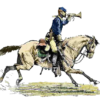I want to reload 32 Winchester Special ammo for my dad's Model 55 Winchester built in the 1920s and my Model 94 built in the 1960s.
Since his gun is nearing 100 years old, I would like to be kind to it and load with lighter loads with lead bullets.
My problem is that finding data for lead bullets for the 32 WS in most current load books is almost non-existent.
There is data for jacketed but very little current data for lead.
Does anyone have any suggestions? Also, is it possible (safe) to use jacketed data for lead bullets.
Any help would be appreciated
Since his gun is nearing 100 years old, I would like to be kind to it and load with lighter loads with lead bullets.
My problem is that finding data for lead bullets for the 32 WS in most current load books is almost non-existent.
There is data for jacketed but very little current data for lead.
Does anyone have any suggestions? Also, is it possible (safe) to use jacketed data for lead bullets.
Any help would be appreciated








